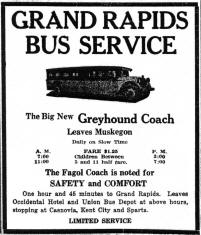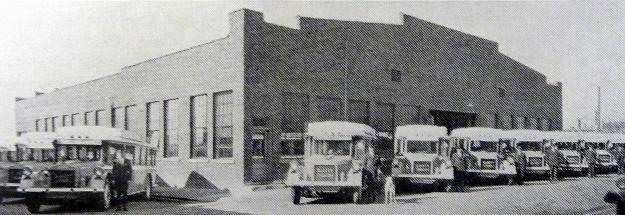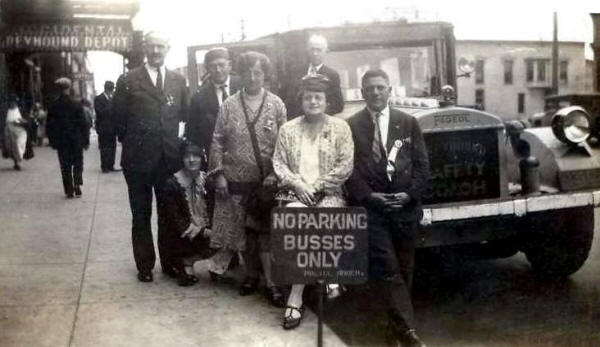|
Where Greyhound Got Its Name
The E.C. Ekstrom Story
|
|
Safety Motor Coach Lines
|
|
 Born in 1889, Edwin
Carl Ekstrom, a native of
Ludington, MI, launched Safety Motor Coach Lines in 1924 with the purchase
of four Fageol 22-passenger intercity buses.
Providing intercity service between Muskegon, MI and Grand Rapids, MI, the firm
instantly became a direct competitor to local interurban service. Born in 1889, Edwin
Carl Ekstrom, a native of
Ludington, MI, launched Safety Motor Coach Lines in 1924 with the purchase
of four Fageol 22-passenger intercity buses.
Providing intercity service between Muskegon, MI and Grand Rapids, MI, the firm
instantly became a direct competitor to local interurban service.
Working with his brother Robert, in early 1925 service out of Muskegon was
expanded to include daily runs to Ludington and to Grand Haven and Holland.
Soon after, lines running from Grand Rapids to Fremont and from Traverse
City to Petoskey were added to the growing company. 
In August of 1925, the company expanded service to six main trunk lines by adding service to Chicago. The battle to dominate
passenger transportation to the Windy City was on.
Using Fageol Safety Coaches built
in Oakland, California, the buses were painted blue and trimmed in
white. Ekstrom’s company incorporated the phrase
"Ride The Greyhounds" in advertising and painted a logo beneath
the driver's side window of the fleet that featured a
greyhound in full stride. The "Greyhound" line even included some
open air observation coaches. December 1925 reports
noted the purchase of $15,000 in snow plow equipment to maintain service
through the winter. By January of 1926, the "Greyhound" line
operated 40 coaches covering an estimated 8,000 miles daily. In March of
1926, press reports mentioned the purchase of a pair of double deck coaches, seating 56
passengers for summer use.
The company's general offices were located in a 100 by
134 foot brick building in downtown Muskegon equipped with everything needed
for the operation of the lines. In Muskegon, buses picked up passengers at
the Union Bus Depot, located at Western Avenue and Terrace Street, as well
as at the Occidental and Muskegon hotels. In addition, two depots were
maintained in Grand Rapids, with one each in Holland, South
Haven, Grand Haven, Benton Harbor and Chicago. Waiting room facilities
were provided in all other towns on the routes.
|
|
|

|
|
The
General Offices of the Safety Motor Coach Lines - The Greyhound Lines,
located
in downtown Muskegon, MI.
|
Initially, riders paid drivers
at each starting point. Fares, were "a little
higher than the interurbans and slightly lower
than the steam roads." As popularity of the service grew, the company
added a new cardboard ticketing service in 1926 to speed service. Carrying
over 45,000 passengers monthly, it was estimated that the ticket system
would save "10 minutes and upward per trip to the passengers."
In April 1926, "the fiftieth Fageol
coach purchased within the year was received by the company, making 61
coaches in all. Special ceremonies marked the occasion when (Edwin) Ekstrom was presented with a beautiful Greyhound dog by
the Fageol company. Asked what he would name the
mascot of the popular line, Mr. Ekstrom replied,
'Bus' - so the live Greyhound is called."
|
 |
Riders pose next to a Safety Motor Coach bus at
the Occidental Hotel in downtown Muskegon, MI. |
|
A Humble Beginning
|
|
The Ekstrom
family moved from Ludington to Hibbing, MN in 1898. Raised in Hibbing, Ekstrom received his start in the transportation
industry in the northern Minnesota town. Educated as a certified public
accountant, he began working with Carl Eric Wickman
and Mesaba Transportation Company
in 1916. Operating "one of the first long-distance bus lines between
Hibbing and Wisconsin Rapids, in 1919 Ekstrom
became an officer in a division of Mesaba.
Hibbing is officially credited as the birthplace of what would become
Greyhound Corporation.
|
|
|
|
The Big Bang known as Motor
Transit Corporation
|
|
In late October 1926, the news
hit the press. Ekstrom, along with a series of
partners had formed a new company to be known as Motor Transit Corporation. A holding company organized
under the laws of Delaware, along with Safety Motor Coach Lines, the new corporation acquired controlling interest in
numerous other interstate and intrastate bus lines. With the move, it
was announced that the ten million dollar company would operate service
across 10,000 miles of road in Michigan, Minnesota, Wisconsin, Illinois, Indiana,
Ohio, Kentucky, Missouri and Texas. Headquarters would be based out of
Chicago. Ekstrom would serve as president,
general manager and on the board of directors along with his brother Robert, F. W.
Sullivan, Foster G. Beamsley, Carl Eric Wickman, Earl W. Bradley, Richard L. Griggs and Stephen
R. Kirby. The consolidation would ultimately form the basis of the
Greyhound.
Motor Transit Corporation would rename itself
Northland Greyhound Corporation in 1929. Continued acquisitions of local
and regional motor coach lines created the modern-day transportation
company, but it is a slightly modified version of Ekstrom's
logo from Safety Motor Coach Lines that became the nationwide symbol of
Greyhound.
|
|
|
|